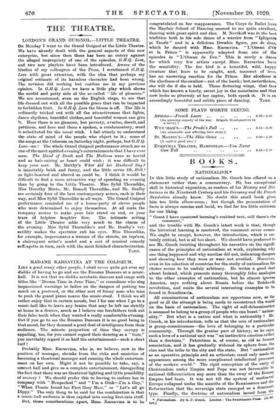MADAME KARSAVINA AT THE COLISEUM.
Lure a good many other people. I shall never quite get over my dislike of having to go and see the Russian Dancers at a music- hall. It is not that we dislike acrobatic dancers and songs with titles like " Dream Time in June Time," or comedians who sing Impassioned warnings to ladies on the dangers of putting too much on a postcard, or the other sort of funny man who tries to push the grand piano nearer the music-stool. I think we all rather enjoy that in certain moods, but I for one when I go to a music-hall like to leave any brains that may be left me strictly at home in a drawer, much as I believe our forefathers took out their false teeth when they wanted a really comfortable evening. But if you go to see the Russian Dancers it is no good being in that mood, for they demand a good deal of intelligence from their audience. The minute proportion of time they occupy is appalling, too, for you cannot regard their dancing as a "turn," you inevitably regard it as half the entertainment—such a short half !
Probably Mme. Karsavina, who is, we believe, now in the position of manager, shrinks from the risks and anxieties of becoming a theatrical manager and running the whole entertain- ment on her own. Might it not be possible to take, say, a concert hall and give us a complete entertainment, disregarding the fact that there was no theatrical lighting and little possibility of scenery ? We should prefer this to having to endure her in company with " Henpecked " and "I'm a Gink—l'm a Guy," "When Flossie found her First Grey Hair," or "Let's all go Dippy." The only thing to be said for the combination is that a music-hall audience is thus cajoled into seeing first-rate stuff. But, these considerations apart, Mme. Karsavina is to be congratulated on her reappearance. The Corps de Ballet from the Mayfair School of Dancing seemed to me quite excellent, dancing with great spirit and Elan. M. Novikoff was in the best tradition both in his solo dance of a warrior from " Iphigenia in Tauris " and in a delicious Dresden figure, pas de deux, which he danced with Mme. Karsavina. " L'Oisean d'Or et la Prince" is apparently adapted from one of the episodes in " L'Oiseau de Feu." This is surely a dance for which very few artists except Mme. Karsavina have the sensibility. The fire bird is a beautiful, wild, happy creature that fears to be caught, and, innocent of love, has no answering emotion for the Prince. Her aloofness is the aloofness of the swallow—not of the hawk ; but,nevertheless, she will die if she is held. Those fluttering wings, that face which has known a lonely, secret joy in the mountains and that now looks so piteously at her captor, both speak it. It is an exceedingly beautiful and subtle piece of dancing. Tam


































 Previous page
Previous page